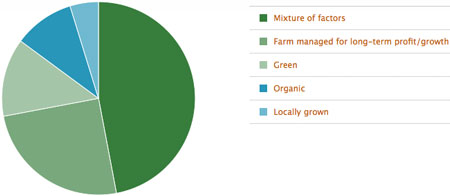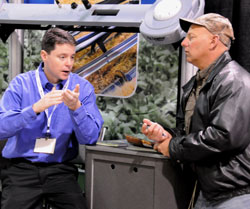 Had the pleasure this week of talking to a great guy, George Ropp of RCMS Consulting, who is 74 years young and still helping farmers—use computer software, no less.
Had the pleasure this week of talking to a great guy, George Ropp of RCMS Consulting, who is 74 years young and still helping farmers—use computer software, no less.
Ropp, of Van Wert, Ohio, decided to get into GPS work after retiring from the county extension service in the early 1990s. “I started grid soil sampling fields for the local elevator, and using the simple software we had back then,” he says. “As the years went on, seeing huge changes in software, I was unsure I would find the capabilities I needed, until I found Ag Leader’s SMS software about six or seven years ago.”
 Not only did Ropp become a fan, he actually built a good consulting business by selling and training growers and retailers on using SMS Advanced, Basic and Mobile software. “I’ve probably sold 50 to 60 copies of the software, and some mobile devices and other equipment, too.”
Not only did Ropp become a fan, he actually built a good consulting business by selling and training growers and retailers on using SMS Advanced, Basic and Mobile software. “I’ve probably sold 50 to 60 copies of the software, and some mobile devices and other equipment, too.”
Ropp takes great pride in helping his clients, often spending a half-day or more with software set up and initial training. “I want to make sure it is set up right, and that the customer is happy,” he says. Now he holds about 4 or 5 training session during winter to keep his customers updated and answer questions.
“More farmers and retailers are getting into variable-rate fertilizer applications and want a software that can handle the necessary equations and building prescription maps. SMS is really easy to use for such operations, and it is really driving software buying” he adds.
Other popular tasks that Ropp is training customers to do are adding layers of soil test data as well as adding soil type maps from NRCS. “I’ve actually created ‘cheat sheets’ on many of these topics, so I don’t have to repeat myself so often,” he laughs.
What’s next? “Well a vacation right now,” he says. But seriously, he sees growing interest in farmers thinking about adding aerial imagery to their field data layers. “I suspect in another year this will greatly increase in popularity.”
His clients greatly value his training expertise on SMS software. “Well, they must, because they keep calling me for advice,” he chuckles. “And I really appreciate the service I get from the software support team at Ag Leader, as even I get stuck every now and then. They are really helpful.”
Visit these links for more information:
SMS Basic http://www.agleader.com/products/sms-basic/
SMS Advanced http://www.agleader.com/products/sms-advanced/
SMS Mobile http://www.agleader.com/products/sms-mobile/
Ag Leader dealer locator http://www.agleader.com/dealer-search/
 I came across a new blog called ‘The Latest Dirt’ by Illinois farmer Jamie Walter who posted a video and his response to the question… “Does guidance/autosteering really pay?” His answer? A resounding YES!
I came across a new blog called ‘The Latest Dirt’ by Illinois farmer Jamie Walter who posted a video and his response to the question… “Does guidance/autosteering really pay?” His answer? A resounding YES!







 Had the pleasure this week of talking to a great guy, George Ropp of RCMS Consulting, who is 74 years young and still helping farmers—use computer software, no less.
Had the pleasure this week of talking to a great guy, George Ropp of RCMS Consulting, who is 74 years young and still helping farmers—use computer software, no less.
 I took a look at what’s new with Precision.AgWired.com sponsor,
I took a look at what’s new with Precision.AgWired.com sponsor,